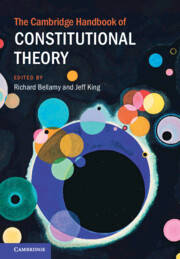Book contents
- The Cambridge Handbook of Constitutional Theory
- The Cambridge Handbook of Constitutional Theory
- Copyright page
- Contents
- Figures
- Contributors
- Frontispiece
- Preface and Acknowledgements
- 1 Introduction
- Part I Values
- Part II Modalities
- Part III Institutions
- Part III. A The State
- Part III. B The Executive
- 37 Presidentialism, Parliamentarism, and Their Hybrids
- 38 Prerogative
- 39 The Administrative State
- 40 Executive Rulemaking
- Part III. C The Democratic System
- Part III D The Legal System
- Part III E The Global System
- Part IV Challenges for Constitutional Democracy
- Bibliography
- Index
- References
37 - Presidentialism, Parliamentarism, and Their Hybrids
from Part III. B - The Executive
Published online by Cambridge University Press: 27 March 2025
- The Cambridge Handbook of Constitutional Theory
- The Cambridge Handbook of Constitutional Theory
- Copyright page
- Contents
- Figures
- Contributors
- Frontispiece
- Preface and Acknowledgements
- 1 Introduction
- Part I Values
- Part II Modalities
- Part III Institutions
- Part III. A The State
- Part III. B The Executive
- 37 Presidentialism, Parliamentarism, and Their Hybrids
- 38 Prerogative
- 39 The Administrative State
- 40 Executive Rulemaking
- Part III. C The Democratic System
- Part III D The Legal System
- Part III E The Global System
- Part IV Challenges for Constitutional Democracy
- Bibliography
- Index
- References
Summary
The chapter discusses the comparative constitutional theory of parliamentary and presidential government as well as various hybrids. It suggests that the much-discussed perils of presidentialism, to the extent that they exist, may largely be due to the kind of personalism that results from directly electing a fixed-term president. When the comparative study of executive formats goes beyond the standard trichotomy of parliamentary, presidential, and semi-presidential systems, we can see that the branch-based separation of powers can be analytically and practically separated from executive personalism. Hybrid systems such as “assembly-independent” government in Switzerland or “semi-parliamentary” government in Australia can be understood as efforts to reap the benefits of powers separation while avoiding the perils of executive personalism. Cogent arguments for the direct election of a fixed-term president are hard to find, despite the widespread belief that it is inherently more democratic.
Keywords
- Type
- Chapter
- Information
- The Cambridge Handbook of Constitutional Theory , pp. 640 - 655Publisher: Cambridge University PressPrint publication year: 2025

